Contents
The use of circles helps not to be left without a catch in the “deaf” season, when the pike is practically not interested in various spinning lures, as a result of which the effectiveness of spinning tackle is close to zero.
The design of the mug for pike fishing
Structurally, a circle is a disk made of lightweight non-sinking material with a diameter of 100 to 200 mm and a thickness of 20-35 mm. Typically, mugs are made from hard foam, some woods, and plastics. A groove was made along the edge of the mug for laying the necessary piece of fishing line, in the middle a signal pin was threaded, which is a key element of the tackle. The thickness of the pin usually does not exceed 10-12 mm, the optimal length is 13-15 cm. You should not equip the tackle with a too long pin, this will lead to an increase in the number of false positives, which in turn can negate the effectiveness of fishing.
The pins are usually made with a slight taper, which makes their fastening easier and more reliable. The lower part of the pin is thickened or made in the form of a ball, the main thing is that in the working design, in an inverted form, the lower part protrudes minimally above the base of the circle. The top of the mug is usually painted bright red, the bottom white. If foam is used, the lower part is left unpainted.
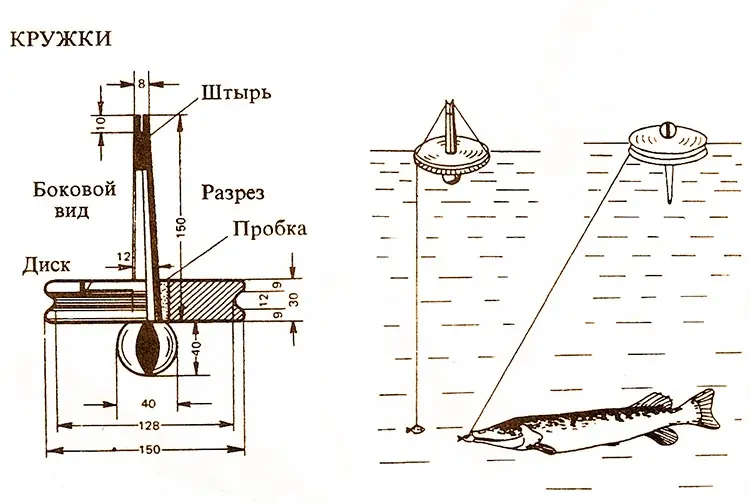
In the upper part of the circle on opposite sides there are two small slots for fishing line, another slot is made in the upper part of the pin. Slots are needed to fix the fishing line in working order, before placing the circles on the water in the fishing grounds.
Equipment for pike fishing circles
When catching pike, two types of equipment are usually used: classic and with a retractable leash.
In the classic version, a sliding “olive” sinker weighing from 5 to 10 g is used (as a rule, this range is enough), a carabiner with which the leash is attached and a rubber (silicone) stopper or bead to protect the knot. A rubber stopper is preferable as it allows the lead to be fixed higher, giving the bait bait more freedom. The use of a carabiner is mandatory, because often when fishing on circles, a predator swallows the live bait offered to him deeply, it is easier to unhook the leash and put on a new one. In the case of using lung leashes, a swivel can be used by attaching the leash to the rig using the loop-in-loop method.
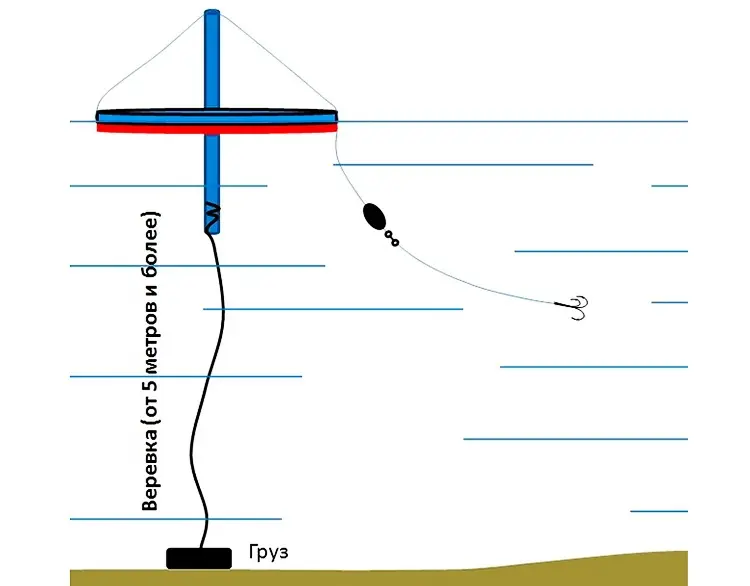
The second option looks like this. An end sinker is attached to the main line, and the leash is tied higher. You can use a triple swivel, make a loop, or tie the leash directly to the main line with a special knot. The latter option is preferable, since it is less bulky, in addition, the leash can be moved with effort along the main line, which means that you can choose the required fishing horizon depending on the reservoir and the intended predator. More precisely, it is not the leash itself that is tied, but a piece of fishing line of a slightly smaller or similar diameter with a carbine (clasp), and the leash is already attached to it.
The weight of the sinker is selected according to the conditions of fishing. The main purpose of such equipment is to “attach” the circle to a specific place. On a stagnant pond, 10 g is enough, the shape does not play a special role, but 20-50 g should already be used in the course, and preferably with a flat bottom side. However, it should be understood that fishing in this way is possible only in a weak current, since a stronger one will simply turn the circle over.
The thickness of the main fishing line for pike fishing varies from 0,3 to 0,5 mm. In the summer, the predator is not so picky about the thickness of the fishing line and, as a rule, when she sees the live bait, she grabs it without problems. You can also use braid. The stock of fishing line should be 10-15 m, and in particularly deep waters up to 20-30 m. There were cases when a circle with a small supply of fishing line was simply pulled into snags by a pike, as a result of which the tackle was lost, since the moment of bite was not visible, but, consequently, the place of his drowning remained unnoticed.
Leads for rigging fishing circles
First of all, leashes differ in the type of material. The easiest to manufacture are leads made of thick fishing line, with a diameter of 0,6-0,8 mm, they are made single-core. With such a thickness, they quite tolerably resist pike teeth, however, we prefer to use double leashes from thinner fishing line with a diameter of 0,25-0,4 mm. The fact is that they are more flexible, which gives an advantage in case of a poor bite of a cautious fish. This leash is not XNUMX% insured against a bite, however, despite the fact that the predator sometimes frays one of the veins, it, as a rule, manages to be brought to the second.
In recent years, more wear-resistant fluorocarbon, which is also less noticeable to fish, has made it possible to increase the reliability of such mounting. The cost of this material, of course, is higher than simple nylon, but it also lasts longer. The only thing to remember is that there are leash and “spinning” fluorocarbon. It is more difficult for a lead pike to bite, but it is also more rigid. Spinning is softer, and in the version of a two-core leash it can be used no less successfully.
Making your own harness is easy. We fold the fishing line of the required length (40-60 cm) in half and knit 3-4 ordinary knots along the entire length, and the first knot should be 5-10 mm from the eye of the hook so that a possible snack falls on the next segment, thereby leaving the possibility of playing on one of the two woods. The last knot is made double or even triple to avoid spontaneous untying. The live bait is placed “under the gills”: the free end is brought in from the inside of the gills and removed through the mouth, after which a double is inserted into the outer loop.
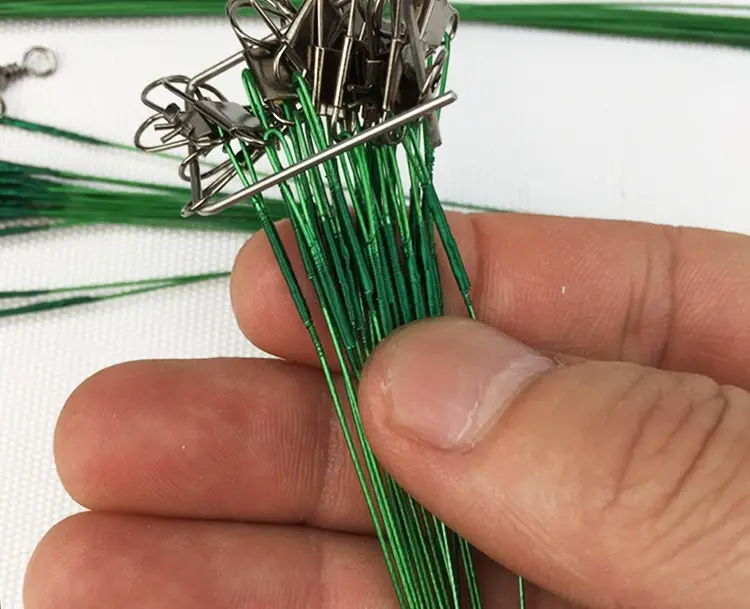
Previously, in conditions of scarcity and the absence of other options, leashes were made from thin steel wire for aircraft modeling or guitar string. Their manufacture requires more time, soldering is necessary for reliable fastening. The leash is inserted into the live bait’s mouth and removed either through the gills or through the anus.
These leashes were replaced by tungsten leashes. The planting of live bait is carried out in the same way as with a double line. A pike will not bite such a leash with all the desire, but tungsten has a well-known minus – the memory of the material. Often, after the first bite, it curls into a spiral and becomes unsuitable for further fishing. You can straighten it, for this you need to take the leash with two pliers and, stretching it over the flame of a gas burner, warm it up, as they say, red hot. At this point, it is important not to overdo it, because a heated thin leash can be torn. After such a simple procedure, it becomes perfectly straight again. However, it can be used with one leash no more than 3-4 times, since the material inevitably loses strength and can fail at the most inopportune moment.
Nylon-coated spinning steel leashes are good to use. They are quite cheap and durable, and the neutral color of the shell masks them well. Before use, we remove all accessories, we catch a double, and we plant the live bait in a manner similar to the previous one.
Currently, in fishing stores there is a huge amount of all kinds of leader materials: from simple steel to expensive titanium, single and multi-strand. All of them are suitable for use. The best ones will be those in which the end loops are fixed with a winding, since it is more difficult to put the live bait with crimped tubes, and they injure the gills more.
When setting a live bait on a tee under the dorsal fin, in contrast to winter fishing on vents, there are many idle bites, so I prefer special double hooks that the predator swallows without problems, without noticing the catch.
What is the best live bait for pike fishing
For catching pike on mugs, crucian carp is considered the best live bait. Catching him is not difficult. It is found in almost all ponds and quarries, pecks actively, does not disdain most of the baits offered to it. The baited crucian behaves briskly, directing the circle in one direction or the other, thereby attracting the attention of the predator.
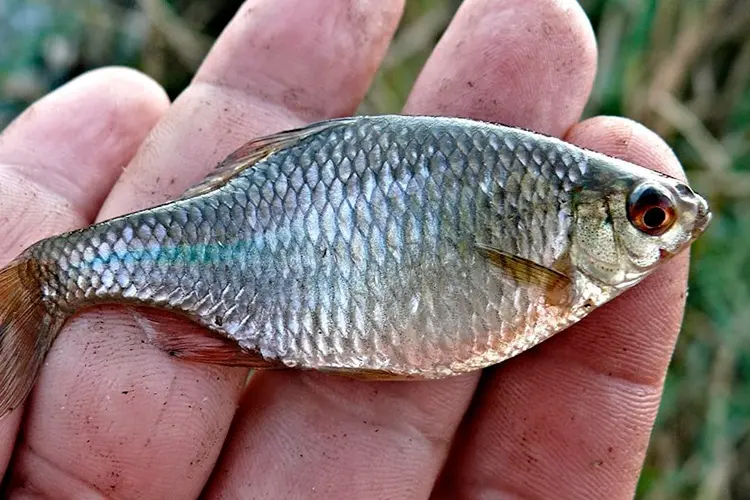
In general, almost any small fish is suitable as live bait, but sometimes you have to take into account the tastes of pike in a particular reservoir. In some places, she prefers roach and minnows, bypassing perches, in others she actively takes on ruff. There are also things that are not paradoxical. With active biting, there are usually no special problems with live bait, you have to adjust if the pike starts to act up. Usually it is the middle of summer.
It happens that the live bait is too large, and it is not possible to put it in the usual way, because every now and then he strives to turn the circle over. In this case, there is one trick: to pass the fishing line not through the tip of the pin, but by wrapping it closer to the base. The lever in this case will be minimal, and it is more difficult for a large live bait to make a false bite. The predator, at the moment of the grip, will turn the circle over without any problems.
Hook and method of bait bait
For equipment, 4 types of hooks are used: single, double symmetrical, double asymmetrical, tees. The pike takes the prey across, after which, with deft movements of the jaw, it turns its head towards its own esophagus. Many anglers argue that the bait fish should be hooked only to the head area, since it goes into the mouth first.
There are three ways to do this:
- With the help of a double through the gills. A double hook should not be soldered together, although such models are also used by anglers. The double is released from the leash, after which the leash is passed through the gills and out of the mouth. Next, the hook is returned to its place and adjusted so that only the sting sticks out of the mouth.
- Triple crochet under the lower lip. It is important not to damage the vital organs so that the fish remains active. Usually a tee is hooked to a live bait under the lower lip.
- Single hook for the upper lip or nostril. There are no important organs in this area, so this method is always good and works perfectly. It is much easier to break through the mouth of a pike with a single hook, it is less traumatic for young predators, so you can always let go of small things that have pecked.
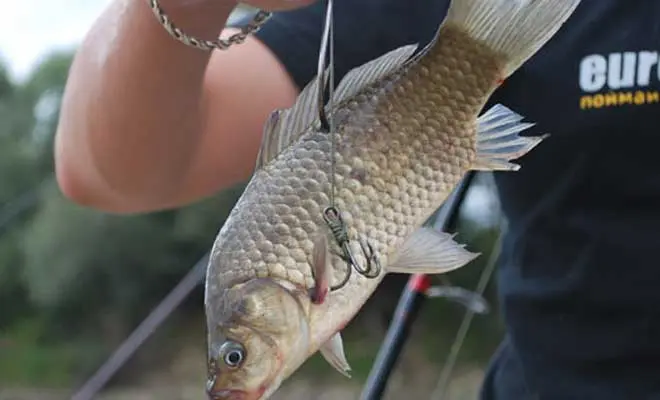
Photo: orybalke.com
The dorsal fin hook method is also popular among anglers. An asymmetrical double hook is recommended for him, however, singles and tees are also used. A method of replanting a live bait by the tail is also known, but it is less popular because it has a higher percentage of gatherings. A fish planted by the tail plays more actively in the water, so this method can be used with a high passivity of the pike.
Seasonal pike fishing on mugs
Each season in its own way attracts lovers of catching predatory fish species. In spring, nature blossoms, pike becomes more active, and catches are larger. In summer, small fish bite more often, while activity drops, because there are many shelters around, a good food base. An increase in water temperature also does not play into the hands of the angler. In summer, the bite is short, so the size of the catch does not always please the hunters for the “toothy”.
Spring
Fishing in this period of the year with circles for pike is possible only in reservoirs with open navigation. By federal districts, the opening dates of the season vary: in some regions, you can go on the water from March, in others – in April or even May. In regions with closed navigation, it is possible to go fishing only in private fishing grounds by agreement with the local administration. As a rule, a certain fee is charged for visiting the reservoir. Also, some farms require sportsmanship and catch-and-release fishing.
Benefits of spring fishing:
- fish size;
- bite frequency;
- spills and accessibility of multiple locations;
- high pike activity.
The flood makes many swampy shallow waters suitable for fishing. If in the summer there is practically no predator, then in the spring with a good flood it comes a lot. It is important to take into account the spawning ban and observe the catch rates. As a rule, boating is prohibited during spawning.
Spawning, like navigation, has different periods for the regions of the country. Before fishing, it is necessary to clarify information about the ban on fishing, so as not to violate the law, both human and natural. The pike begins to spawn even under the ice, so navigation is often opened when the predator has spawned.
There is little time for fishing in the spring, as numerous prohibitions interfere with fishing. At this time of the year, after spawning, an excellent pike hatches. The post-spawning zhor lasts several weeks and it is important to get to the reservoir during this period.
Circles are placed closer to the coastal zone: in snags, on the edge, in the windows of the reeds and along the cattail wall. Also popular are the exit zones to the bays, channels, where the predator keeps in the spring. In spring, the pike leaves the depths and walks along the coast in search of food.
Summer
With the advent of heat, the bite on the live bait in circles weakens. In some regions, there are still bans, so fishing there does not begin until July. Arrange mugs either at night or early in the morning. As a rule, the activity of the predator does not last long: a couple of hours in the morning and, perhaps, a little in the evening.
The best results can be achieved on rivers, where the current mixes the water masses, saturating them with oxygen. Running water always remains colder, so the fish in the summer are more active there.
You can find pike in summer in dense vegetation:
- along the coastline;
- under littered trees;
- water lilies in the windows;
- among the reeds, cattail;
- in the overgrown upper reaches of the lakes.
Circles should be placed near shelters, since in the heat the fish move little. Of particular interest to the fisherman are shallow sections of rivers, changing into pits. The depth in them can reach 1,5-2 m, the banks, as a rule, are overgrown with water lilies, dragged on with mud. Fishing from the shore in such a place will not work, so arranging circles from a boat is ideal.
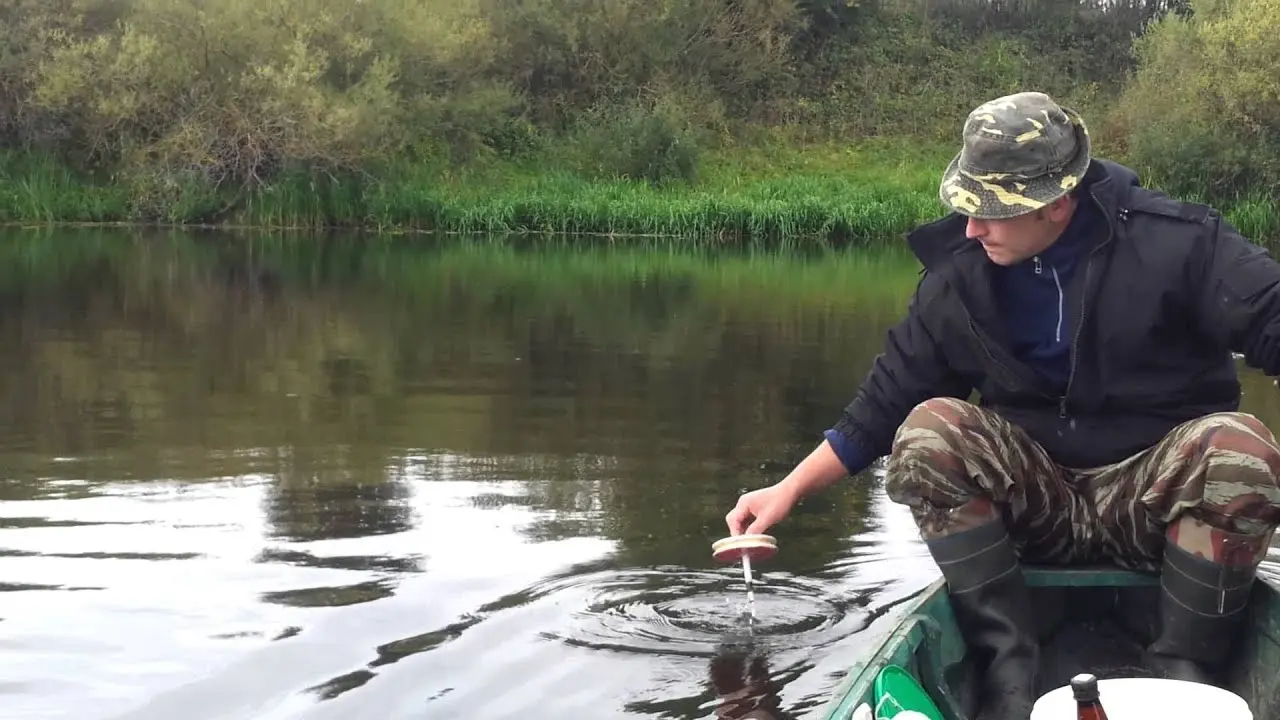
Photo: youtube.com channel “Fishing”
It is important to place gear in plain sight so that in the event of an attack, you can quickly navigate and swim to the triggered gear. The abundance of summer vegetation often hides the bite, especially if fishing is carried out in reed thickets.
Activity peaks in early June and August when the nights turn cold and the water temperature plummets. August brings good trophies, because the predator begins to eat before wintering. At this time of the year, it is best to use a larger live bait fish that cannot be swallowed by a small thing. A crucian with a palm will be interested in a toothy trophy, in addition, this fish is mobile and keeps energetic on the hook for a long time.
Autumn
Perhaps the best time to fish for a predator with mugs is autumn. Before winter, the pike eats off, replenishes fat reserves, which will help to cope with the cold.
In autumn, the following areas are used to install circles:
- exits from the pits;
- sharp turns of rivers;
- areas with piers, platforms;
- snags and grassy irrigation.
The pike prefers to bypass the rapids, but it often occupies places with a slow and medium strength current. In autumn, fish are perfectly caught not only in rivers, but also in lakes, ponds and reservoirs. The water temperature is dropping, the vegetation is fading and there are more places for the angler to set up gear.
In autumn, a larger live bait should be used than in summer and spring. For fishing in the current, vents are used, “tied” to the place with a bottom load. A sharp change in weather affects the biting negatively. If in the warm season a sudden rain favored the activity of the predator, then in autumn a stable atmospheric front is the key to successful fishing. It is also important to monitor the pressure, its drops can harm, and the pike will “close its mouth”.
Choosing a place on the pond to install circles
Reservoirs can be conditionally divided into closed (lakes and ponds) and open (rivers and reservoirs). It is quite easy to “read” the ponds, the greatest depths are located near the dam and along the channel, and the upper reaches are shallow. First of all, you should pay attention to areas with vegetation. The predator loves to lie in wait for prey in such places, as they have both shelter and a good food supply.
The fishing scheme is simple. You can put circles both along the border of the grass at some distance, and in the “windows”, in which case they will not float away on their own. Near the grass, the predator is especially active in the morning and evening hours, often large specimens come out at this time, however, during the day the same pike is not averse to hiding in the thickets.
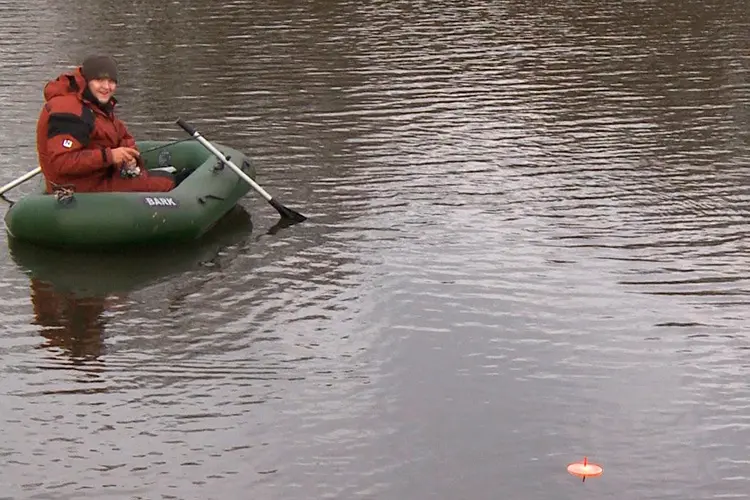
Deep places should not be ignored, because in the vast expanses and predators are very diverse, and real trophies can be caught. The main thing to keep in mind is that a thermocline forms in summer, and the fish prefer to stay in the upper, although warmer, but much more oxygen-rich layer, and not at the bottom, despite the fact that the temperature there is more comfortable. Often, on a site with a depth of 4-5 m, it is enough to set a descent of 1-1,5 m, and bites will not be long in coming.
Equipped circle on the water:
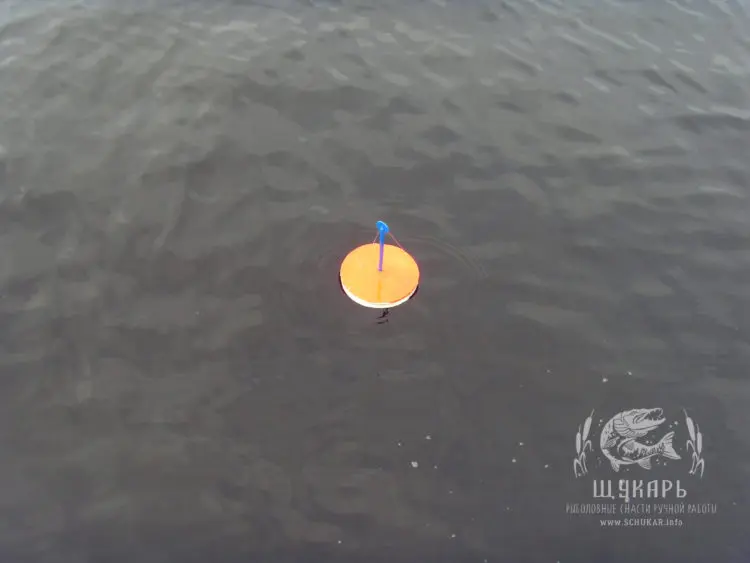
“Worked” circle. The pike attacked the live bait and the circle turned over:
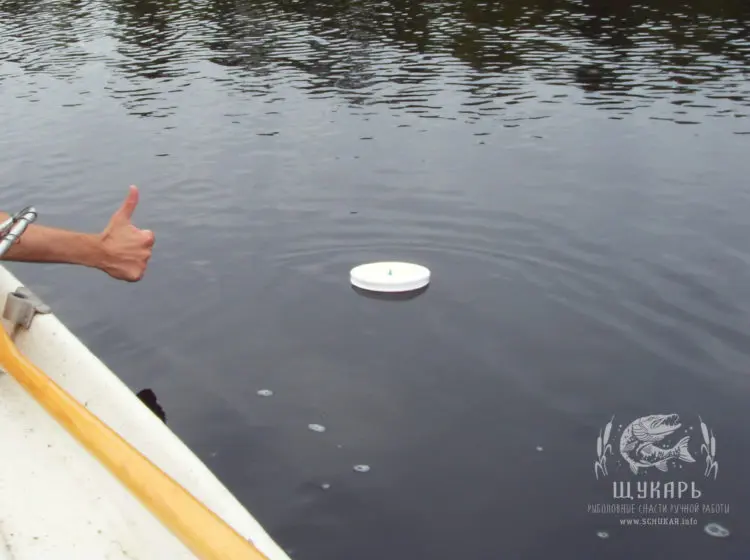
You can search for promising areas using several methods:
- echo sounder and readings of the bottom topography, depth;
- manual measurement of the water column with a marker rod;
- placing circles around visible ambushes (snags, plants, etc.);
- by examining the map of the depths of the reservoir.
The lakes have a more intricate shape and relief, but they are generally easy to study. First of all, we notice aquatic vegetation and snags; open places, as in the previous case, are not bypassed. Of course, you can measure the depths using an echo sounder or even a simple depth gauge, but it’s better to either select a specific area and put gear on it, or place them pointwise throughout the pond in the places you like the most. A circle is not a vent and will not stand in one place, but knowing the direction of the wind, you can predict the movement of gear and set the desired trajectory. It should be borne in mind that if the circle moves from depth to aground, then the live bait, having reached the bottom, will try to hide in the grass, becoming inaccessible to the predator.
During summer pike fishing in circles, late in the evening, as well as before and immediately after sunrise, there is usually a calm, and the circles do not float far from the installation site. At other times, even a light breeze carries them along. In terms of fishing a larger area, this is good, but in the end, all the gear can get lost in one area, and also get tangled in the grass. In this case, several anchored circles with a branch leash are used, and the classically equipped ones are arranged in a special way. To do this, anglers use a rare lonely vegetation. Positioning the circle in such a way that part of its area lies on a water lily or other plants, or even put the stems on top, clinging to the pin. The vegetation should be sparse and, preferably, stretched by the wind over the surface, so that there is free space under it, and the live bait could not wrap the fishing line around the stem.
Catching pike on circles on the rivers
The use of circles on rivers has its own characteristics. For obvious reasons, places with a noticeable main jet and rifts are unsuitable. It is best to approach a stretch with a weak current.
In this case, there are two options for fishing. You can use moored circles, which essentially perform the functions of a live bait donk, or you can catch a section of the river, over and over again letting ordinary tackle down the stream. In the second option, it is more convenient to fish from two boats: one angler launches circles, the second controls them downstream. It is advisable to use 5 circles, it is quite troublesome to handle a large number of circles on the river, there is always a chance to overlook and lose the tackle that was carried away by the current.
Separately, it is necessary to highlight fishing in the backwaters and bays. In general, it is the same as on the ponds due to the lack of current, however, tackle should not be left close to the exit to the river, since both the wind and a lively predator that has fallen can drag the circle onto the main stream. If you do not notice this in time, then you will most likely have to say goodbye to him. In general, fishing on the river is more difficult, but the catch is more varied.
Fishing with the use of circles can be extremely interesting, despite the seeming passivity of this activity. Moreover, such pike fishing can be successfully combined with active methods of fishing, for example, hunting for a predator with spinning.









